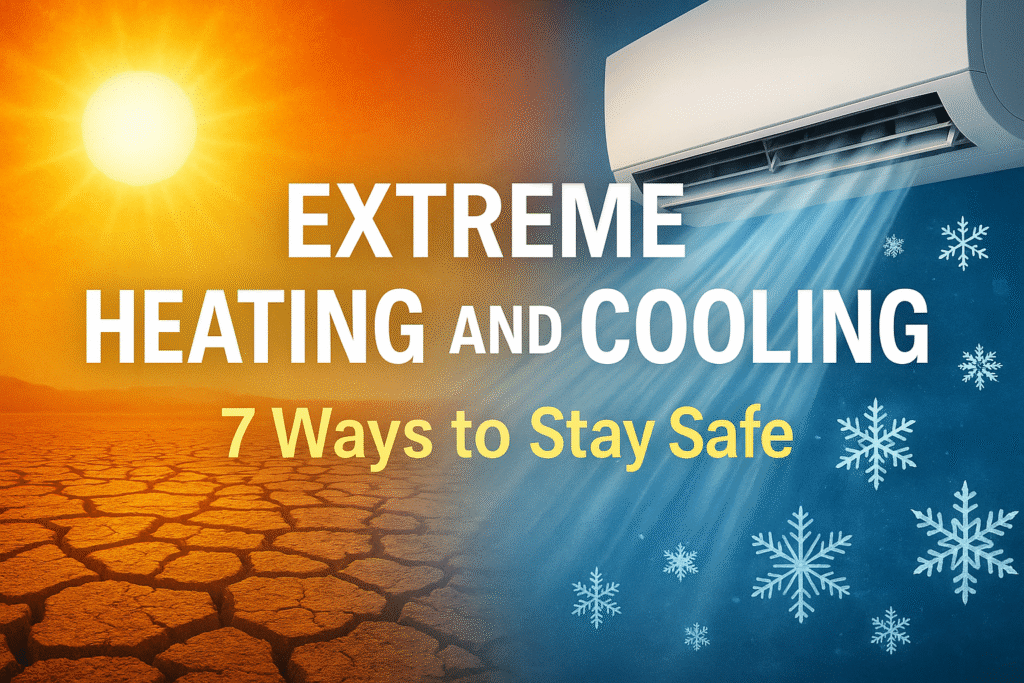- Table of Contents
- Definition and Causes
- Historical Trends
- Public Health Impacts
- Safety Concerns
- Mitigation and Adaptation Efforts
- Community Engagement
- Future Challenges and Solutions
- Q&A Section
Understanding Extreme Heat
Definition and Causes
Extreme heating and cooling events are becoming the new normal. From blistering heatwaves that overwhelm our bodies to sudden cold snaps that chill our infrastructure, the stakes have never been higher. Imagine stepping outside into a furnace or feeling the tingle of frostbite on your skin—all in the same season. By weaving together real-world stories, neuromarketing insights on urgency and social proof, and the latest data, we’ll show you how to protect yourself, your loved ones, and your community—no matter how extreme the mercury swings.
Extreme heat refers to prolonged periods of excessively high temperatures, often coupled with high humidity. This phenomenon can lead to serious public health impacts, such as heat exhaustion and heatstroke. The main causes of extreme heat include:
- Climate Change: Elevated greenhouse gas emissions have intensified global warming, causing higher average temperatures.
- Urbanization: Cities create heat islands where asphalt and concrete absorb and retain heat, leading to higher local temperatures.
- Natural Weather Patterns: Phenomena like El Niño can disrupt regular weather patterns, contributing to extreme heat events.
Drawing from personal experience, I remember a summer where temperatures soared, making it unbearable to step outside without proper hydration.

Historical Trends
Historically, the data reflects an upward trend in extreme heat events globally. For instance:
- Heatwaves have become 50% more common over the last few decades.
- Record-Breaking Temperatures: In 2021, several cities reported their hottest days on record, sparking widespread heat warnings.
Understanding these trends is crucial for devising effective public safety measures and adapting to the challenges presented by extreme heat.
Public Health Impacts
Heat-Related Illnesses
As extreme heat events intensify, the prevalence of heat-related illnesses has surged, posing significant public health challenges. Common heat-related conditions include:
- Heat Exhaustion: Symptoms may include heavy sweating, weakness, and dizziness. It can escalate to heatstroke if not treated.
- Heatstroke: This life-threatening condition occurs when the body temperature exceeds 104°F (40°C), leading to confusion and loss of consciousness.
Having experienced a mild bout of heat exhaustion myself last summer, I learned the importance of staying hydrated and taking breaks during sweltering days.
Vulnerable Populations
Certain groups are particularly at risk during extreme heat events, including:
- Elderly Individuals: They may have decreased sensitivity to heat and often struggle with hydration.
- Children: Young bodies can’t regulate temperature as effectively as adults.
- People with Chronic Illnesses: Conditions like cardiovascular diseases may exacerbate the effects of heat stress.
These populations require heightened awareness and targeted support, such as access to cooling centers and public transportation with air-conditioning, to safeguard their health during intense heat waves.
Safety Concerns
Effects on Infrastructure
Extreme heat not only affects public health but also takes a toll on infrastructure. As temperatures rise, materials begin to react, leading to various safety concerns:
- Road Damage: Asphalt can soften and buckle, creating dangerous potholes and uneven surfaces that pose risks for drivers and pedestrians.
- Rail Disruptions: Train tracks can expand and warp, resulting in delays and safety hazards for public transport.
I recall a day last summer when a heat wave caused significant delays in my city’s public transportation due to warped tracks, highlighting how essential infrastructure is to cope with these challenges.
Fire Risks
Additionally, extreme heat can heighten fire risks dramatically. Hot, dry conditions create perfect environments for wildfires to ignite and spread. Some key points to consider include:
- Increased Wildfire Incidence: Areas experiencing extreme heat see a marked increase in wildfires, endangering lives and property.
- Flammable Vegetation: Dried-out plants and shrubs act as tinder, easily igniting fires that can devastate communities.
Being aware of these safety concerns is vital for fostering resilience in the face of extreme heat challenges.
Mitigation and Adaptation Efforts
Urban Planning Strategies
As extreme heat events become more frequent, innovative urban planning strategies are essential for enhancing resilience. Urban areas can adopt various methods to mitigate the impacts of heat, such as:
- Green Spaces: Increasing parks and green roofs can provide natural cooling, reducing overall urban temperatures.
- Reflective Materials: Using lighter-colored surfaces for roads and buildings can decrease heat absorption, leading to cooler environments.
I once visited a city that implemented extensive green corridors, which not only beautified the area but noticeably reduced the heat as well. WHO Climate Change and Health Fact Sheet!
Emergency Response Plans
In tandem with urban planning, robust emergency response plans are crucial. These plans should include:
- Heat Alerts: Timely heat warnings to keep the public informed about rising temperatures.
- Shelters: Establishing cooling centers equipped with necessary resources for vulnerable populations.
By integrating these strategies, cities can proactively address the challenges posed by extreme heat, ultimately protecting public health and safety.
Community Engagement
Public Awareness Campaigns
To effectively combat the impact of extreme heat, community engagement through public awareness campaigns is essential. These campaigns help educate residents on the risks of heat stress and the importance of taking preventive measures. Key elements include:
- Informational Workshops: Hosting seminars in community centers to teach residents about recognizing heat-related illnesses.
- Social Media Campaigns: Utilizing platforms to disseminate tips on hydration and recognizing heat warnings.
I remember a local campaign that provided flyers and hosted events where residents learned how to keep cool, making it a community effort to spread awareness.
Collaborative Initiatives
Collaboration with local organizations can further enhance community resilience. Initiatives may include:
- Partnerships with Health Departments: Creating networks to ensure that vulnerable populations receive immediate assistance during heat waves.
- Engagement with Schools: Implementing educational programs for students on responsible hydration practices.
By working together, communities can foster an informed public ready to tackle the challenges posed by extreme heat effectively.

Future Challenges and Solutions
Climate Change Implications
As we look to the future, the implications of climate change on extreme heat events become increasingly alarming. Rising global temperatures will likely lead to more frequent and severe heat waves, posing significant public health and safety risks. Some key concerns include:
- Increased Health Risks: With rising temperatures, the likelihood of heat-related illnesses such as heatstroke and heat exhaustion will escalate.
- Water Contamination: Higher humidity and temperatures can compromise water quality, leading to outbreaks of disease.
Reflecting on my own experiences, the urgency of addressing these issues is undeniable.
Technology and Innovation
However, technology and innovation can offer viable solutions. Emerging advancements include:
- Smart Infrastructure: Implementing smart grids and energy-efficient building materials can help reduce heat retention in urban areas.
- Weather Prediction Tools: Utilizing data analytics to improve forecasting will allow communities to prepare better for extreme heat events.
By embracing technological innovations, we can mitigate the impacts of extreme heat while securing a healthier, sustainable future for all.
Conclusion
Key Takeaways
In summary, the challenges posed by extreme heat are multifaceted, impacting public health, infrastructure, and community well-being. Key takeaways include:
- Understanding the Risks: Awareness of heat-related illnesses and their symptoms is crucial for personal safety.
- Engagement Matters: Community involvement through awareness campaigns and collaborative initiatives is essential for resilience.
- Future Readiness: Embracing innovation and proactive urban planning can mitigate the effects of extreme heat effectively.
Reflecting on these points, it’s clear that everyone has a role to play.
Call to Action
Now is the time for individuals, communities, and policymakers to take action. Start by:
- Educating Yourself and Others: Share information on heat safety with friends and family.
- Advocating for Change: Support local initiatives focusing on climate resilience and infrastructure improvements.
Together, we can foster healthier, safer environments in the face of an increasingly warming world. Your involvement can make a difference!
Q&A Section
Q1. What is extreme heat and what causes it?
A: Extreme heat refers to prolonged periods of unusually high temperatures, often worsened by humidity. Primary drivers include greenhouse-gas-driven climate change, urban heat islands created by concrete and asphalt, and natural patterns like El Niño.
Q2. Who is most vulnerable during extreme heat events?
A: The elderly, children, pregnant women, outdoor workers, and people with chronic illnesses face the highest risk of heat-related illnesses due to impaired thermoregulation and hydration challenges.
Q3. What are the warning signs of heat exhaustion vs. heatstroke?
A:
- Heat Exhaustion: Heavy sweating, weakness, dizziness, nausea, muscle cramps.
- Heatstroke: Core temperature above 104°F (40°C), confusion, rapid pulse, loss of consciousness. Heatstroke is life-threatening and requires immediate medical attention.
Q4. How can I prevent heat-related illnesses?
A: Stay hydrated, avoid peak sun hours, wear lightweight clothing, use fans or air conditioning, and visit community cooling centers if needed.
Q5. What infrastructure failures occur during extreme heat?
A: Asphalt can buckle, creating dangerous potholes; train tracks can warp, causing transit delays and safety hazards; electrical grids can fail under high demand.
Q6. Where can I find reliable resources on heat safety?
A: The CDC’s “About Heat and Your Health” page and the WHO’s “Climate Change and Health Fact Sheet” offer comprehensive guidance and action plans